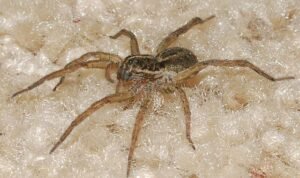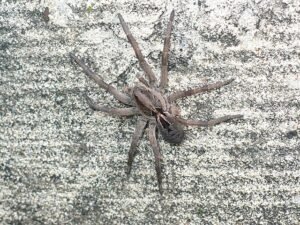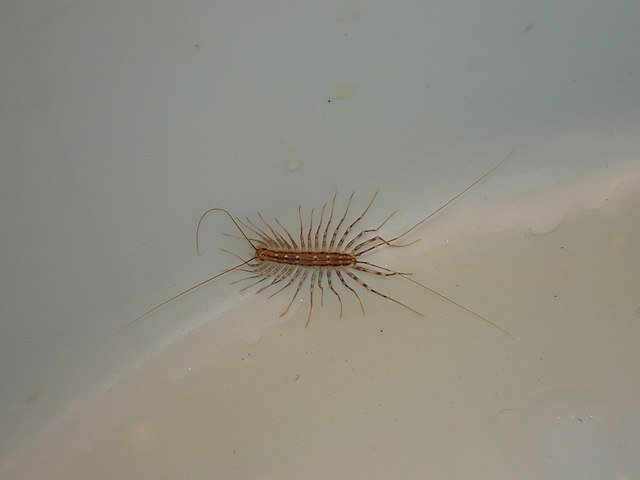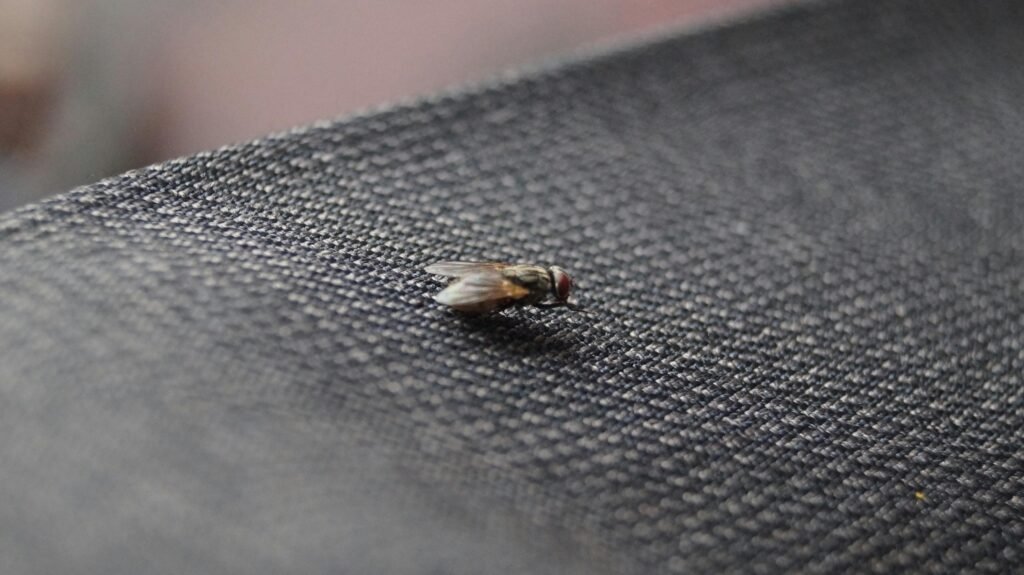Wolf Spiders (Lycosidae): Identification, Behavior & Control
 The Wolf Spider (Lycosidae) is one of the most widespread and fascinating spiders in the world. Unlike web-building species such as House Spiders (Parasteatoda tepidariorum) or Cellar Spiders (Pholcidae), wolf spiders are active hunters. They stalk and chase prey across the ground, earning their name from their wolf-like hunting style.
The Wolf Spider (Lycosidae) is one of the most widespread and fascinating spiders in the world. Unlike web-building species such as House Spiders (Parasteatoda tepidariorum) or Cellar Spiders (Pholcidae), wolf spiders are active hunters. They stalk and chase prey across the ground, earning their name from their wolf-like hunting style.
Found in gardens, fields, basements, and even urban homes, wolf spiders play an important ecological role as predators of insects like Cockroaches, Mosquitoes, Earwigs, and even occasional household pests such as Silverfish.
Although their appearance—large bodies, hairy legs, and fast movement—often triggers fear, wolf spiders are not aggressive toward humans. In fact, they are more beneficial than harmful, serving as natural pest managers both indoors and outdoors.
Identification
Size: Ranges from 10 to 35 mm depending on the species.
Color: Typically gray, brown, or dark patterned to blend with soil or vegetation.
Body: Robust, hairy body with strong legs adapted for running.
Eyes: Eight eyes arranged in three rows; the middle pair are large and forward-facing, giving them excellent vision.
Behavior: Active hunters—do not spin sticky webs to catch prey. Instead, they ambush or chase it down.
Quick Distinction
Wolf Spiders (Lycosidae): Ground hunters, no capture webs, excellent eyesight.
House Spiders (Parasteatoda tepidariorum): Build messy webs in corners to trap flying insects.
Cellar Spiders (Pholcidae): Long-legged web spinners with delicate frames.
Biology and Lifecycle
 Egg sacs: Female wolf spiders carry round egg sacs attached to their spinnerets, unlike most spiders that hide them in webs.
Egg sacs: Female wolf spiders carry round egg sacs attached to their spinnerets, unlike most spiders that hide them in webs.Spiderlings: Once hatched, spiderlings climb onto the female’s back and are carried for several weeks—a unique feature among spiders.
Lifespan: Typically 1–2 years, though some larger species may live longer.
Reproduction: Mating occurs in spring or summer; females may produce one or two egg sacs in a lifetime.
Hunting strategy: No sticky webs; instead, they ambush prey or actively chase it using speed and eyesight.
Ecology and Distribution
Worldwide presence: Wolf spiders are found on every continent except Antarctica.
Habitats outdoors: Gardens, meadows, forests, crop fields, deserts, and wetlands.
Habitats indoors: Basements, garages, sheds, and ground-floor corners, especially in autumn when seeking warmth.
Food source: Insects and other arthropods—Mosquitoes, Cockroaches, Earwigs, Crickets, Silverfish, and small beetles such as Carpet Beetles.
Role in ecosystems: Control insect populations naturally, serving as biological pest control agents.
Risks and Misconceptions
Bites: Wolf spiders rarely bite unless provoked or trapped. Bites may cause mild pain, redness, and swelling but are not medically significant.
Myth: Many people confuse wolf spiders with dangerous spiders like brown recluse (Loxosceles reclusa). Wolf spiders are not lethal.
Fear factor: Their large size, hairy appearance, and speed often exaggerate their threat.
Real risk: The only true nuisance is their presence indoors and the potential for bites in rare cases.
Signs of Infestation
Frequent sightings of large, fast-moving spiders near floors or walls.
Egg-carrying females in basements or garages.
Presence of shed exoskeletons near baseboards or storage areas.
Higher numbers in homes located near fields, gardens, or wooded areas.
Household Control
Sanitation: Regular cleaning reduces prey populations (e.g., Cockroaches, Earwigs, Fungus Gnats).
Exclusion: Seal cracks, gaps, and doors to keep spiders from entering.
Outdoor lighting: Reduce lights that attract flying insects like Mosquitoes, which wolf spiders feed on.
Clutter control: Store boxes off the floor in basements and garages to minimize hiding spaces.
Natural deterrents: Sticky traps can help monitor and reduce numbers indoors.
Professional and Long-Term Control
Integrated Pest Management (IPM): Address underlying insect prey populations rather than focusing solely on spiders.
Chemical options: Residual insecticides may be applied in cracks and crevices in severe infestations.
Moisture control: Dehumidifiers can make basements less attractive.
Professional inspection: A licensed pest control expert can determine whether wolf spiders indicate a broader insect issue indoors.
Final Thoughts
The Wolf Spider (Lycosidae) stands out among common arachnids because it doesn’t rely on webs to trap its prey. Instead, it stalks and hunts like a miniature predator. This unique behavior makes it both feared and admired.
For homeowners, wolf spiders are usually more of a visual nuisance than a danger. Their size and speed can be unsettling, but they rarely bite and cause no lasting harm. In fact, they provide a beneficial role by reducing populations of insects such as Cockroaches, Earwigs, and Mosquitoes.
The best long-term strategy is prevention and cleanliness: sealing cracks, removing clutter, reducing moisture, and controlling indoor insect populations. Chemical treatments are rarely necessary unless spider numbers are very high or linked to larger infestations.
In the bigger picture, wolf spiders are part of a natural pest control system. Their presence in gardens, fields, and even homes shows that nature is always at work, balancing ecosystems—even in our basements and backyards.
FAQs About Wolf Spiders
Q: Are wolf spiders dangerous to humans?
A: No. While large and intimidating, wolf spiders are not considered dangerous. Their venom is mild and not harmful to humans.
Q: Do wolf spiders chase people?
A: No. Wolf spiders may run quickly if startled, which can look like chasing, but they are simply trying to escape.
Q: How long do wolf spiders live?
A: Most live 1–2 years, though larger species may survive longer in favorable environments.
Q: Can wolf spiders infest houses?
A: Wolf spiders don’t infest homes in the same way pests like Silverfish or Carpet Beetles do. They may wander indoors but do not reproduce heavily inside.
Q: What should I do if I see a wolf spider in my house?
A: You can remove it manually or vacuum it up. Long-term, focus on sealing entry points and reducing insect prey.
Disclaimer
This article is for informational purposes only. Pest control laws and approved chemicals vary by country. For best results and legal safety, we strongly recommend contacting a licensed pest control professional in your local area. Always make sure that the pest control technician is properly certified or licensed, depending on your country’s regulations. It’s important to confirm that they only use approved products and apply them exactly as instructed on the product label. In most places in Europe, UK, or USA, following label directions is not just best practice—it’s the law.
Author
Nasos Iliopoulos
MSc Agronomist & Certified Pest Control Expert
Scientific Director, Advance Services (Athens, Greece)
Licensed Pest Control Business – Ministry of Rural Development & Food (GR)
References
Wikipedia – Wolf Spiders
Britannica – Wolf Spiders

 Egg sacs: Female wolf spiders carry round egg sacs attached to their spinnerets, unlike most spiders that hide them in webs.
Egg sacs: Female wolf spiders carry round egg sacs attached to their spinnerets, unlike most spiders that hide them in webs.
